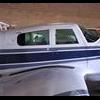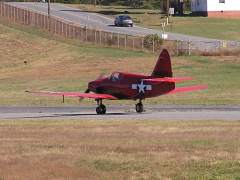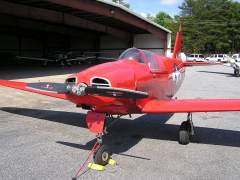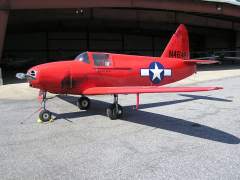-
Posts
465 -
Joined
-
Last visited
Content Type
Profiles
Forums
Blogs
Gallery
Downloads
Media Demo
Events
Everything posted by Steve65E-NC
-

Historic Aircraft
Images added to a gallery album owned by Steve65E-NC in Old MooneySpace.com Images
-

Early Al Mooney Design, Hickory, NC
Steve65E-NC posted a gallery image in Old MooneySpace.com Images
From the album: Historic Aircraft
-
From the album: Historic Aircraft
-

WWII Al Mooney designed Culvar target Drone
Steve65E-NC posted a gallery image in Old MooneySpace.com Images
From the album: Historic Aircraft
-
Byron, Thanks, that led me to tons of good info. Particularly the Glassair summary. Any suggestions on sourcing the 0-Rings. Aircraft Spruce says one of them is backordered. Steve
-
I would like to better understand the fuel injection system on my Lycoming IO-360 A1A. Who manufactured it, what adjustments are on it, and how is it maintained? Reference to web resources appreciated. On the 100 hour inspection sample from the Service Manual, I read about finger screens to be cleaned (not the injector screens). Where and what is the deal on this.
-
Why fly around with a VOR 4 degrees off. That is an easy adjustment. Talk to your radio shop or ask around.
-
You do not mention your Starter Type. I never had any problem with cold-starts on my 65E. But, hot-starts were always more or less of a problem. I experimented with every technique. I often just went ahead and flooded it on purpose and did a full throttle, flood-clear, start (be ready on the mixture and throttle). Finally, I just wore out my old starter and it came apart in place. I did some research and installed a Sky-Tec 149-NL. It spins the engine over so fast that hot starts are just no longer a problem no matter. I think many others have had similar experience. The starter I purchased has a shear pin that can be sheared by back-fire (I carry spare pins, but starter removal would be required - never heard of it happening to anyone). However, if you have cold start problems sounds like something else may also be a problem. I might start by having someone disassemble the key switch and clean all contacts (careful, lots of little parts but logical arrangement).
-
Why not build a box around the pallett. A sheet of 3/8"plywood and some 2x2 for all inside corners should do nicely. A skill or bench saw and some 2" deck screws and you are off and running. Maybe some metal strapping around the whole assembly when finished.
-
Have you talked to Triad Aviation, Burlington, NC. http://www.hhtriad.com/ta.asp . Talk to shop manager Othman Rashed 336-227-1467. They have a very good reputation locally and Othman has always been very helpful to me during 21 years of Mooney ownership. They are a lot closer to you than TX.
-

Fuel tank leak & hydraulic flaps not working
Steve65E-NC replied to Tmarsha's topic in Vintage Mooneys (pre-J models)
The flap hydraulic pump is not that difficult to rebuild and Lasar has a kit available. However, you should probably try bleeding the line first. Assuming that you do not have an aftermarket one piece belly, this involves identifying the correct piece of sheet metal to remove so that you can get to the flap pump, and its attached drain bib. It is best to bleed from the bottom up as the line does not clear well with a down bleed. Several yards of clear plastic tubing (about 1/8 id), a positive displacement hand pump oil can (less than $10 at Lowes or Home Depot) full of new hydraulic fluid, a fitting with barb and correct pipe thread for the top of the hydraulic fluid reservoir, a catch jar for the top overflow, and some sort of rubber bulb or bottle pump to return fluid level in the reservior back down to fill level all complete the rig. After you get it working pump the flaps up and down a number of times and look for any leak near the pump. You might want to use the same rig to bleed both brake lines bottom-up, while you are at it and before you remove the pump thru fitting and catch jar. -

Fuel tank leak & hydraulic flaps not working
Steve65E-NC replied to Tmarsha's topic in Vintage Mooneys (pre-J models)
You did not mention if the tanks have ever been resealed. However, in any case it is worth a trip to Don Maxwell MSC in TX for a spot-reseal and overall tank sealant evaluation. He has the detective work for finding spot leaks down to a science and will do you right. Finding the source of the leak is a large part of the problem as it will not be obvious. In any case it is worth making Don's association early in your ownership as he knows Mooneys inside and out. And, he generously shares his knowledge: here, on his web site, and in the MAPA Journal. -
I called two local gas companies. They say refill of E medical only with prescription. $26 quoted for refill, no exchange program. Still probably workable. How is the best way to assemble the other bits and pieces (regulator, flow indicators, canulas) for system.
-
Seems like a good idea. Who does these exchanges and at what cost. Where do you acquire this type bottle and at what cost. How long will a single bottle serve two at say 18,000 ft. Any problems changing out a bottle at altitude, looks like it is one at a time.
-

67'F EGT panel hole size EDM700
Steve65E-NC replied to mschmuff's topic in Vintage Mooneys (pre-J models)
As promised, here are three photos of my angled right side mounting for EDM700. Again, this little angled subpanel was contrived to solve a yoke interference problem. But, it gives the pilot a better view. Also note: Velcro pencil mount. I always know where my pencil is. Also note: Co-pilot yoke mount for secondary timer oriented for left seat visibility and operation. Timer velcroed to wood block sawed to angle toward pilot, 1/4" hole or holes, cable ties. Also note: White on clear Labeling of all instruments for when flying young folks. -

67'F EGT panel hole size EDM700
Steve65E-NC replied to mschmuff's topic in Vintage Mooneys (pre-J models)
Hank, Please explain again why I can not take my wind up clock out of the yoke (which I have done dozens of times), screw a nice cover plate over the opening, and mount an electric clock in the panel to meet FAA clock requirements. Lots of the GPS mounts on the yoke, seen on this forum, obstruct the view of the yoke clock. Oh, excuse me I have to go wipe the slobber off my chin. -

67'F EGT panel hole size EDM700
Steve65E-NC replied to mschmuff's topic in Vintage Mooneys (pre-J models)
Maybe put a clock (no depth problem) in the old gauge hole and take the clock off the yoke to make room for your handheld GPS or mini Ipad. In the next day or so I will be at the airport and take a photo of my right-side mounting. The visibility is good but you have to reach across to tap the two buttons (which you will be doing frequently, particularly while making LOP adjustments). The JPI in itself does not need or benefit from being on the left or "shock mounted" side of the panel. The less weight on that side the better. I really like my EDM 700. It paid for itself in a spate of partially plugged injector events shortly after some tank work. And, it allows me to run LOP with confidence, even without a flow meter. An additional argument for the right side mounting - that is probably where the other engine instruments are located. -

67'F EGT panel hole size EDM700
Steve65E-NC replied to mschmuff's topic in Vintage Mooneys (pre-J models)
You forgot to attach the photo. But, I assume that you meant "above the co-pilot yoke". About two decades ago I had a JPI installed in that location by a well known shop. Some time later, I determined that the JPI was too long and was actually limiting the movement of the control yokes. What to do?? I made up a little sheet metal panel overlay for the instrument to mount to. The overlay angled the instrument toward the pilot. I attached this sheet metal part to the panel with screws. This addition gave a better instrument view to the pilot and just swung the tail end of the instrument out of the way of yoke movement. More than one way to skin a cat. -
Hugo, I think the read back is just an accuracy check and is something short of a committment to action or compliance. I have read back clearances that I did not begin to understand until I had studied the charts. Bet this has, or will, come up in a court case. Steve
-
As recalled from my Coast Guard OCS radio training. Roger means only received with no commitment to action implied. If you mean to comply you say Wilco (will comply). Wikipedia confirms this and states that Roger was just the phonetic R before Romeo (the Letch!!) won the day. So Roger is just a radio stand in for R (received). This is and was particularly appropriate for shipboard communication where the radio operator is seldom the decision maker. I think the appropriate response to an ATC direction/instruction/mandate (by a single pilot or radio operator in command of aircraft) is usually Wilco. Though you seldom hear it used. Steve65E-NC
-
Again, for a reasonably fast sell, I think the paint job and paint condition are more important than anything about the engine. Anyone will realize that your low time first run, good compression, cylinders will reflect in the cost and quality of an overhaul (when the buyer chooses to have it done). What is the condition of the paint job?
-
It is my understanding, maybe incorrect, that 100 octane can be produced without lead or ethanol. So that leaves the vapor problem. I am talking about a non-lead, specialized, aviation fuel.
-
If the solution requires something like double wall counterflow or closed loop (working fluid and radiator) cooling for some fuel distribution lines, that can be worked into the STC.
-
I think the octane and ethanol problems can be solved for a specialized aviation fuel. I am more concerned about the morning we wake up and there is no more tetra-ethyl lead. As I understand, the major problem in shifting from 100LL to a mogas equivalent 100 octance is the vapor problem. If the fuel is still specially manufactured and colored and controlled for aircraft that does not bother me. The only thing worse than high price fuel is no fuel at all. Then every ramp becomes a scrap metal yard. I understand that lead has a marginal, high temp, lube function in our engines but I am pretty sure there are non-lead additives that can work around that. Apparently from the above, this problem was solved for some Cherokees with redundant full-time fuel pumps. It is past time to move ahead and solve it for the rest of the fleet. Steve 65E-NC
-
Seems like there are enough Mooneys, Cherokees, Bellancas, Beachcraft etc out there for someone to solve this problem with a specialized, full time, auxiliary fuel pump. If everyone so effected threw in $5.00 I bet it would be more than enough to solve the problem and get STCs developed for all the affected aircraft. Maybe someone like AOPA would get involved to organize the effort. I think the time is running short.







